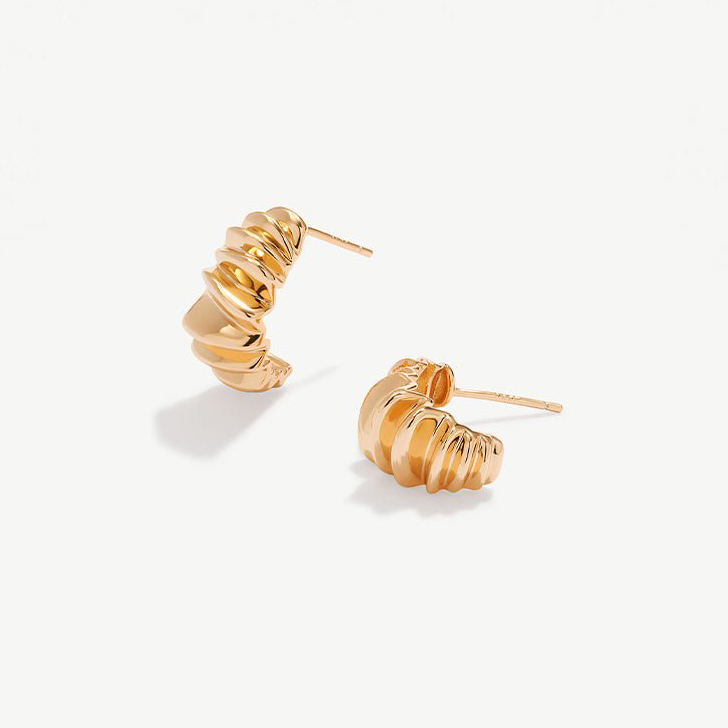Manufacturing Irregular-Shaped Earrings: Best Materials and Techniques
Introduction
Irregular-shaped earrings have become a major trend in contemporary jewelry design, offering unique, artistic, and avant-garde aesthetics. Unlike traditional symmetrical designs, irregular earrings embrace asymmetry, organic forms, and abstract geometry, making them highly sought after in fashion-forward markets.
However, producing irregular earrings requires specialized materials, techniques, and craftsmanship to ensure durability, wearability, and aesthetic appeal. This article explores:
- The best materials for irregular earrings
- Key manufacturing processes
- Design considerations
- Quality control measures
- Market trends and consumer preferences
By understanding these factors, manufacturers and designers can create high-quality, stylish, and durable irregular earrings that meet market demands.
1. Best Materials for Irregular-Shaped Earrings
The choice of material significantly impacts the earring’s durability, weight, hypoallergenic properties, and finish. Below are the most suitable materials:
1.1 Metals
A. Sterling Silver (925 Silver)
- Pros: Affordable, lightweight, hypoallergenic, easy to shape.
- Cons: Can tarnish over time (requires rhodium plating).
- Best for: Handcrafted, textured, or oxidized irregular designs.
B. Vermeil Gold (Gold-Plated Sterling Silver)
- Pros: Combines sterling silver’s affordability with gold’s luxury.
- Cons: Requires proper plating (minimum 2.5 microns) to prevent wear.
- Best for: High-end irregular earrings with a gold finish.
C. Brass & Bronze
- Pros: Malleable, ideal for intricate designs, cost-effective.
- Cons: May cause allergies (requires nickel-free plating).
- Best for: Bohemian, rustic, or vintage-inspired earrings.
D. Stainless Steel & Titanium
- Pros: Extremely durable, hypoallergenic, corrosion-resistant.
- Cons: Harder to shape (requires laser cutting).
- Best for: Industrial, futuristic, or minimalist irregular designs.
E. Solid Gold (14K, 18K, 22K)
- Pros: Luxurious, tarnish-resistant, long-lasting.
- Cons: Expensive, heavier than other metals.
- Best for: High-fashion, bespoke irregular earrings.
1.2 Alternative Materials
A. Acrylic & Resin
- Pros: Lightweight, vibrant colors, customizable shapes.
- Cons: Less durable, prone to scratches.
- Best for: Artistic, statement-making earrings.
B. Wood & Bone
- Pros: Eco-friendly, lightweight, natural aesthetic.
- Cons: Fragile, sensitive to moisture.
- Best for: Ethnic, boho, or sustainable jewelry lines.
C. Gemstones & Pearls
- Pros: Adds elegance, unique textures.
- Cons: Requires expert setting, higher cost.
- Best for: Luxury irregular earrings with organic shapes.
2. Key Manufacturing Processes for Irregular Earrings
2.1 Design & Prototyping
- Hand Sketching & CAD Modeling:
- Designers create freehand sketches or use 3D CAD software (Rhino, Matrix, ZBrush) for precision.
- 3D Printing (Rapid Prototyping):
- Resin or wax prototypes are printed to test shape, weight, and wearability.
2.2 Metal Shaping Techniques
A. Laser Cutting
- Best for: Stainless steel, titanium, or brass.
- Advantages: Ultra-precise, ideal for sharp-edged irregular designs.
B. Hand Fabrication (Forging & Soldering)
- Best for: Sterling silver, gold.
- Advantages: Allows organic, freeform shapes.
C. Casting (Lost-Wax & Sand Casting)
- Best for: Intricate, textured irregular earrings.
- Process:
- Wax model is created.
- Mold is formed around wax.
- Molten metal replaces wax.
D. Electroforming
- Best for: Hollow, lightweight irregular shapes.
- Process: Metal (usually copper) is deposited onto a conductive mold via electrolysis.
2.3 Surface Finishing Techniques
- Polishing: Smooths edges for comfort.
- Oxidation: Adds antique or blackened effects.
- Hammering & Texturing: Creates organic, uneven surfaces.
- Plating (Gold, Rose Gold, Black Rhodium): Enhances durability and aesthetics.
2.4 Assembly & Quality Control
- Earring Posts & Hooks: Surgical-grade steel or gold-plated for hypoallergenic wear.
- Stone Setting (If Applicable): Prong, bezel, or glue-in settings for gemstones.
- Final Inspection: Ensures no sharp edges, proper weight balance, and plating uniformity.
3. Design Considerations for Irregular Earrings
3.1 Weight Distribution
- Problem: Heavy irregular shapes can cause discomfort.
- Solution: Use lightweight materials (acrylic, hollow metal) or balance with counterweights.
3.2 Wearability & Comfort
- Problem: Sharp edges can irritate the skin.
- Solution: Smooth all edges and test prototypes for comfort.
3.3 Aesthetic Cohesion
- Problem: Too much asymmetry can look chaotic.
- Solution: Maintain visual balance through color, texture, or size contrast.
4. Market Trends & Consumer Preferences
4.1 Popular Irregular Earring Styles in 2024
- Organic Asymmetry: Inspired by nature (leaf, coral shapes).
- Abstract Geometric: Unconventional angles and cutouts.
- Mixed-Material Designs: Metal + resin, wood + gold.
4.2 Target Audience
- Fashion-Forward Women (18-35): Seek unique, Instagrammable jewelry.
- Luxury Buyers: Prefer irregular designs in gold or with gemstones.
- Sustainable Consumers: Favor eco-friendly materials like wood or recycled metal.
5. Conclusion: Best Practices for Manufacturing Irregular Earrings
To produce high-quality irregular earrings:
✔ Choose the right material (sterling silver, vermeil, acrylic).
✔ Use precise shaping techniques (laser cutting, hand fabrication, electroforming).
✔ Ensure comfort & wearability (lightweight, smooth edges).
✔ Follow market trends (organic shapes, mixed materials).
By mastering these techniques, manufacturers can create innovative, stylish, and durable irregular earrings that stand out in the competitive jewelry market.
